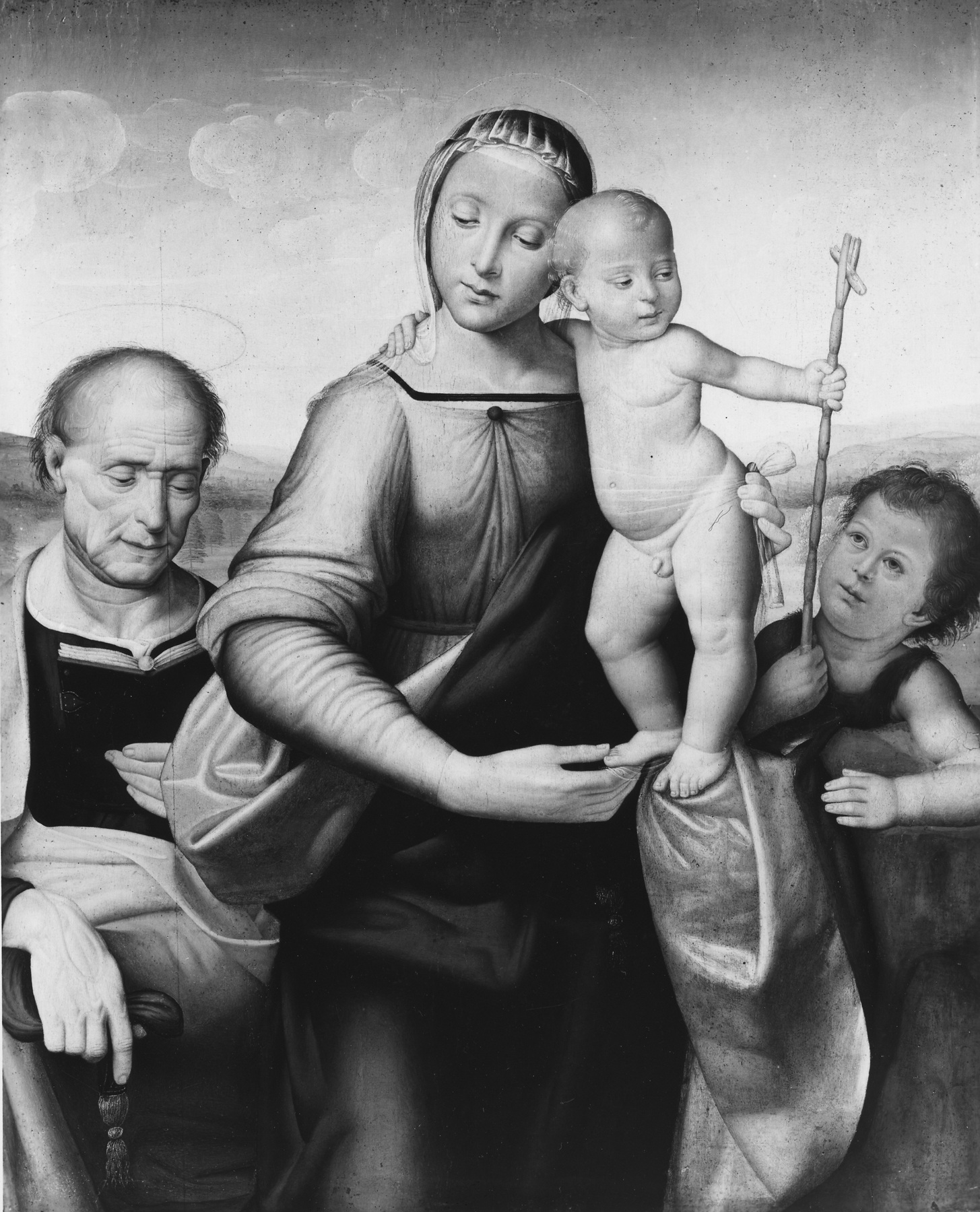The Holy Family with St. John the Baptist
(Renaissance Europe )
The Virgin Mary holds the Christ Child on a rocky outcropping partially covered by her heavy mantle. The Child stands upright in triumphant “contrapposto," a pose derived from ancient Roman sculpture in which the figure's weight is shifted onto one leg. He wraps one arm around his mother’s shoulder and with the other grips the reed cross belonging to his young cousin, John the Baptist. The cross is the typical attribute of John (it references the years he spent preaching in the desert) as well as an allusion to Christ’s death at the crucifixion. Saint Joseph, Mary’s husband and Christ’s earthly father, appears at the left absorbed in a book.
The careful symmetry of the composition, strong chiaroscuro (contrasts of light and dark), and hazy landscape rendered in a technique called “sfumato" (Italian for smoky) are all hallmarks of the High Renaissance style as developed in Italy in the early 1500s by artists like Raphael (1483-1520) and Leonardo da Vinci (1452-1519). The artist of this painting has recently been identified as one of their colleagues, Niccolò Soggi, who is little-known today but who was esteemed by the 16th-century artist and biographer Giorgio Vasari (1511-74). Soggi trained alongside Raphael in the Florentine workshop of Pietro Perugino (ca. 1450-1523; see Walters 37.475) and later led a successful career in his native Arezzo on the southern border of Tuscany between Florence and Rome. The Walters’ painting is especially close to his altarpiece of the “Nativity,” painted in 1522 for the church of Santissima Annunziata in Arezzo.
Provenance
Provenance (from the French provenir, 'to come from/forth') is the chronology of the ownership, custody, or location of a historical object. Learn more about provenance at the Walters.
Paoletti, Florence, around 1910 [mode of acquisition unknown]; Luigi Grassi, Florence [date and mode of acquisition unknown]; Henry Walters, Baltimore, 1911, by purchase [through Bernard Berenson]; Walters Art Museum, 1931, by bequest.
Conservation
| Date | Description | Narrative |
|---|---|---|
| Examination | examined for condition | |
| 9/21/1938 | Treatment | repaired |
| 2/1/1949 | Treatment | repaired |
| 5/7/1952 | Treatment | repaired |
| 1/1/1953 | Examination | examined for condition |
| 1/5/1959 | Treatment | repaired; other |
| 3/7/1960 | Treatment | repaired; coated; re-housed; loss compensation |
| 3/8/1960 | Treatment | repaired; loss compensation; coated |
| 11/29/1984 | Treatment | cleaned; loss compensation; coated |
Geographies
Italy, Tuscany, Arezzo (Place of Origin)
Measurements
Painted surface H: 39 3/4 x W: 31 9/16 x D: 1 1/8 in. (101 x 80.2 x 2.8 cm)
Credit Line
Acquired by Henry Walters, 1911
Location in Museum
Not on view
Accession Number
In libraries, galleries, museums, and archives, an accession number is a unique identifier assigned to each object in the collection.
In libraries, galleries, museums, and archives, an accession number is a unique identifier assigned to each object in the collection.
37.526


